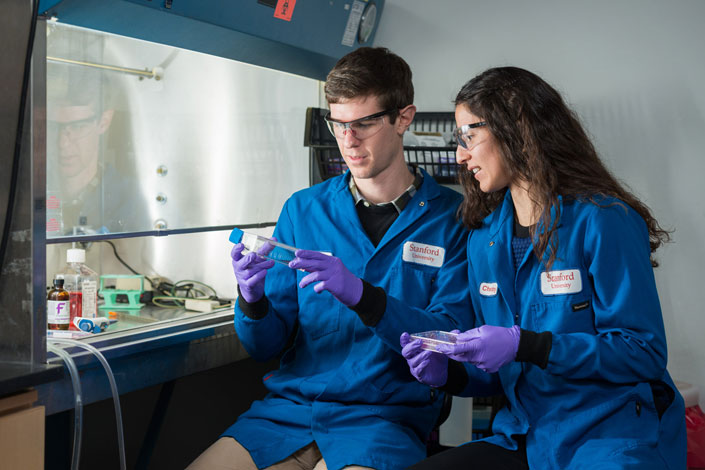


SAN FRANCISCO, Feb. 19 -- Researchers at Stanford University have been refining compounds that would carry instructions for assembling the protein that makes fireflies light up and deliver them into the cells of an anesthetized mouse.
If their technique worked, the mouse would glow in the dark; and if successful in humans, the technique could be useful for vaccines or cancer therapies.
The result shows that not only the mouse glowed, but it also later woke up and ran around, completely unaware of the complex series of events that had just taken place within its body.
The work, in collaboration with chemists and gene therapy experts, is the topic of a paper in Proceedings of the National Academy of Sciences.
"It's almost a childlike enthusiasm we have for this," said chemistry Professor Robert Waymouth, co-author of the study. "The code for an insect protein is put into an animal and that protein is not only synthesized in the cells but it's folded and it becomes fully functional, capable of emitting light."
It is hard enough to get these protein instructions, called messenger RNA (mRNA), physically into a cell, and it is another hurdle for the cell to actually use them to make a protein.
However, the technique is remarkably simple and fast, according to a news release from Stanford. And unlike traditional gene therapy that permanently alters the genetic makeup of the cell, mRNA is short-lived and its effects are temporary. The transient nature of mRNA transmission opens up special opportunities, such as using these compounds for vaccination or cancer immunotherapy.
Gene therapy usually focuses on modifying DNA, the fundamental genetic code. That modified DNA then produces a modified mRNA, which directs the creation of a modified protein. The current work skips the DNA and just delivers the protein's instructions.
Previous work has been successful at delivering a different form of RNA, called short interfering RNA, or siRNA, but sending mRNA through a cell membrane is a much bigger problem. While both siRNA and mRNA have many negative charges, so-called polyanions, mRNA is considerably more negatively charged, therefore more difficult to sneak through the positively charged cell membrane.
What the researchers needed was a positively charged delivery method, a polycation, to complex, protect and shuttle the polyanions. However, this alone would only assure that the mRNA made it through the cell membrane. Once inside, the mRNA needed to detach from the transporter compound in order to make proteins.
The researchers addressed this twofold challenge with a novel, deceptively straightforward creation, which they call charge-altering releasable transporters (CARTs). "What distinguishes this polycation approach from the others, which often fail, is the others don't change from polycations to anything else," said chemistry Professor Paul Wender, co-author of the study.
"Whereas, the ones that we're working with will change from polycations to neutral small molecules. That mechanism is really unprecedented," Wender said.
As part of their change from polycations to polyneutrals, CARTs biodegrade and are eventually excreted from the body.
The researchers said CARTs could move the field of gene therapy forward dramatically in several directions. "Gene therapy has been held up as a silver bullet because the idea that you could pick any gene you want is so alluring," said Jessica Vargas, co-lead author of the study.
"With mRNA, there are more limitations because the protein expression is transient, but that opens up other applications where you wouldn't use other types of gene therapy."

 Award-winning photos show poverty reduction achievements in NE China's Jilin province
Award-winning photos show poverty reduction achievements in NE China's Jilin province People dance to greet advent of New Year in Ameiqituo Town, Guizhou
People dance to greet advent of New Year in Ameiqituo Town, Guizhou Fire brigade in Shanghai holds group wedding
Fire brigade in Shanghai holds group wedding Tourists enjoy ice sculptures in Datan Town, north China
Tourists enjoy ice sculptures in Datan Town, north China Sunset scenery of Dayan Pagoda in Xi'an
Sunset scenery of Dayan Pagoda in Xi'an Tourists have fun at scenic spot in Nanlong Town, NW China
Tourists have fun at scenic spot in Nanlong Town, NW China Harbin attracts tourists by making best use of ice in winter
Harbin attracts tourists by making best use of ice in winter In pics: FIS Alpine Ski Women's World Cup Slalom
In pics: FIS Alpine Ski Women's World Cup Slalom Black-necked cranes rest at reservoir in Lhunzhub County, Lhasa
Black-necked cranes rest at reservoir in Lhunzhub County, Lhasa China's FAST telescope will be available to foreign scientists in April
China's FAST telescope will be available to foreign scientists in April